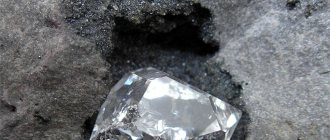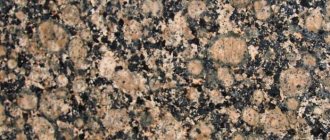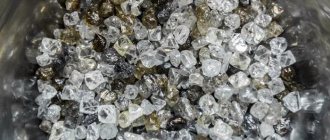- Home page
“Indestructible mineral” - this is what the ancient Greeks called diamond, considering it the frozen tears of the Gods and fragments of stars. The first minerals were found in India and it was from Hindustan that the stone began its conquest of the world. According to ancient Indian ideas, the 5 principles of nature - sky, ether, air, earth and water - merged at the heart of a diamond. Diamonds were divided into 4 castes, where the most transparent stones were equated with brahmins. It was believed that diamonds (stones were divided into male and female) lived on stones, in the sea and on the hills near gold mines. It was believed that if the rock was wetted with May or heavenly dew, the stones would grow and multiply.
Ancient Babylon had its own version of how diamonds appeared on Earth - it was believed that these were splashes of celestial material from which the Gods built the dome of the sky.
There was also a version that the diamond was drops of morning dew petrified under the gaze of the basilisk.
Christianity had both supporters and opponents of diamonds. Supporters believed that diamonds were fragments of the Gates and Walls of Heaven, and radical zealots of the faith explained the appearance of diamonds with fragments of satanic weapons, frozen tears of fallen angels and pieces of frozen hellfire.
Origin of diamonds
Diamond is a mineral, a crystalline modification of pure carbon. Diamonds are characterized by crystallization in the form of octahedrons, less often in the form of a cube. For diamond formation, it is important that the temperature increase as the pressure decreases. These stones are distinguished by their individual uniqueness; it is impossible to find two identical stones - it’s like fingerprints.
Diamonds tend to originate in continental regions with geological stability. In order for carbon to change the form of graphite to a more rigid structure, it must lie at a depth of 100-200 km under the influence of a temperature of 1100 - 1300 ° C.
MORPHOLOGY
Diamond morphology is very diverse. It occurs both in the form of single crystals and in the form of polycrystalline intergrowths (“board”, “ballas”, “carbonado”). Diamonds from kimberlite deposits have only one common flat-faceted shape - the octahedron. At the same time, diamonds with characteristic curved shapes are common in all deposits - rhombic dodecahedroids (crystals similar to a rhombic dodecahedron, but with rounded edges), and cuboids (crystals with a curved shape). As experimental studies and the study of natural samples have shown, in most cases, dodecahedroid-shaped crystals arise as a result of the dissolution of diamonds by kimberlite melt. Cuboids are formed as a result of the specific fibrous growth of diamonds according to the normal growth mechanism.
Cullinan diamond broken into 9 parts
Synthetic crystals grown at high pressures and temperatures often have cube faces and this is one of their characteristic differences from natural crystals. When grown under metastable conditions, diamond easily crystallizes in the form of films and columnar aggregates. The sizes of the crystals vary from microscopic to very large, the mass of the largest diamond, “Cullinan”, found in 1905. in South Africa 3106 carats (0.621 kg). Several months were spent studying the huge diamond, and in 1908 it was split into 9 large pieces. Diamonds weighing more than 15 carats are rare, but diamonds weighing over a hundred carats are unique and are considered rarities. Such stones are very rare and often receive their own names, world fame and their special place in history.
Place of Birth
Which area is most promising for discovering diamonds? If you look at geological maps, the greatest chance of finding a diamond vein will be in areas with the oldest crust of the earth, which contain igneous rocks. Already in these areas we will be interested in “explosion tubes”. Since the rocks that form them often contain magnetic minerals, such zones will be characterized by “magnetic anomalies.” Such pipes are closely associated with cratons, or ancient platforms, that stabilized the Earth's crust during the Archean period. Such platforms exist on almost all continents. The only place where there are no diamond deposits is Antarctica, which is due to the specific formation of minerals.
Explosion pipes represent a type of primary diamond deposit, they are called kimberlite and lamproite. Placers can also act as deposits - these are secondary deposits formed at the site of destruction of bedrock pipes.
Kimberlite and lamproite pipes are a vertically oriented geological body. In essence, it is a pillar, the upper part of which ends in a bulge. When gases break through the earth's crust, a kind of funnel is formed.
- Kimberlite is a volcanic rock, an ultramafic porphyry rock enriched in volatile components (N2, CO2, H2O). Formed from magmas of the deepest origin.
- Lamproite is a magnesium-rich mafic or ultramafic lamprophyre rock. Unlike kimberlite, it contains a large amount of potassium; melts are formed at shallower depths than kimberlite magmas. Lamproite pipes are larger in size than kimberlite pipes.
According to experts, only 10% of the total diamond reserves are concentrated in lamproite pipes, and almost 90% are in kimberlite deposits. Geologists have discovered more than 1,500 kimberlite bodies, and only 8-10% contain diamond rocks.
Largest diamond deposits:
- Aikhal, Yakutia, Russia;
- Argyle, Australia - the only lamproite pipe in the world where industrial development and diamond mining have been established;
- Botuobinskaya, Russian Federation;
- Crater of Diamonds State Park, USA;
- Jwaneng, Orapa, Botswana;
- Catoca, Angola;
- Kimberley, South Africa;
- Kimberlite pipe “Udachnaya”, “MIR”, Russia;
- Field named after V. Grib, Russia;
- M. Lomonosov field, Russia;
- Minas Gerais, Brazil;
- Panna Mines, India.
Classification
There are a huge number of classifications of diamonds according to certain characteristics. The first attempts were made in ancient India, where the color shade of natural stone was taken as a basis. Each of them: transparent, red or gray was likened to a certain human caste of the then society.
Modern methods take as a basis the appearance, presence of impurities, shape, color and a number of other characteristics. Diamonds are such a complex commodity in terms of a set of indicators that even experienced specialists are allowed to make an error (sometimes reaching the level of 15%) in assessing the 6,000 varieties of this precious raw material. However, some simple and convenient landmarks still exist in this endless variety.
First of all, diamonds are divided into technical and jewelry diamonds. The current assortment of the world market is presented:
- 50% low grade small diamonds,
- 35% semi jewelry stones,
- 15% jewelry diamonds.
On the territory of the Russian Federation, the current official document regulating the classification of rough natural diamonds is GOST R 51519.1-99. Where the main features are:
- defectiveness,
- dimension,
- form,
- color.
Mantle-magmatic theory
Proponents of the mantle-magmatic theory believe that diamonds originate from coal seams, which for a long time were in a chemically homogeneous environment under a pressure of more than 5000 Pa. As a result of the breakthrough of magma to the surface from a depth of 150 km, diamonds are carried from the chambers to the surface.
There are 3 groups of magmatic theories:
- Diamonds form in the upper layers of the earth's crust when hydrocarbons from the host rocks enter solidifying magma.
- Diamonds form in ultramafic rocks. Molten magma disintegrates the diamond formation, releases individual units and carries it upward with the magma flow.
- Diamonds are mainly formed in the depths of ultramafic magma, as well as during its release to the surface.
The third version is currently recognized as the most realistic. The concentration of diamonds in the bowels of the earth is quite high; it is not a rare mineral. Another thing is that only a few of the deposits are accessible to humans for industrial production.
Extraction methods
Extraction of minerals to the surface is always associated with serious costs, and the choice of the method itself is largely determined by the depth of the ore rock. Often, having exhausted the capabilities of the surface layers, miners are forced to continue development, going deeper into the bowels of the earth.
Before starting the actual production of useful rock, it is necessary to conduct geological exploration, make a decision that is reasoned from various sides, create the necessary infrastructure, transport people and equipment, organize enrichment and processing.
Shakhtny
Where there is confidence in diamond deposits at a depth of more than 500 meters, the only mining method is the construction of underground structures. Although there are exceptions.
The method is quite expensive and unsafe, but very often it is the only one and also opens up access to new deposits. A serious problem in such cases is water and escaping gases; it is also necessary to constantly monitor the air supply and stable power supply. Inside the mine, mining equipment is constantly operating: combines, loading and unloading machines, conveyor belts, skips. After which the ore mined to the surface is sent for processing.
Career
An industrial method of diamond mining, used everywhere, but associated with drilling operations and the organization of explosions. The raw materials obtained in this way are loaded onto multi-ton dump trucks and sent to a processing plant that extracts diamonds from the rock.
Once one layer is exhausted, the quarry is expanded and deepened as long as conditions allow. If necessary, the mining process often moves into the closed stage of underground mine construction.
Diamond mining
Diamonds of earthly origin
A distinctive feature of all diamond mining quarries is their location in areas with high volcanic activity. Kimberlite pipes are vents left over from volcanoes destroyed by erosion.
It is noteworthy that diamonds of terrestrial origin have a cubic crystal lattice, while diamonds from meteorites have a hexagonal lattice. During the formation process, a diamond crystal absorbs inclusions of melts, fluids and minerals from the external environment. The shade of the mineral depends on the specific embedding of nitrogen atoms into the crystal lattice.
- “C-centers” refer to individual atomic centers;
- If a pair of nitrogen atoms unite under the influence of diffusion, “A-” is formed - these are several “A-centers” united in the plane.
If “C-centers” predominate, the diamond is yellow, “A- and B-centers”, when predominant, form the transparency of the stone.
Diamonds of meteorite origin
Diamonds in meteorite matter were first discovered in 1888 by Russian researchers Lachinov and Erofeev. They discovered the precious inclusions while studying samples of a stone meteorite discovered in Mordovia and named after the place where it was found - New Uraeus. This discovery overturned the hitherto established idea that diamonds can only originate in the depths of the earth’s bowels.
Meteorites with a similar composition of matter are called ureilites. Their peculiarity in composition is carbonaceous (carbonaceous) achondrites. Attempts to detect diamonds in meteorites with a different composition were unsuccessful.
Supporters of the theory of the meteorite origin of diamonds have 2 versions.
- The crystals are already present inside the meteorite. After the meteorite falls, it breaks up and diamonds end up on or close to the surface. These diamonds were called shock or impact diamonds - lonsdaleites. The theory gained popularity after the Canyon Diablo iron meteorite fell in the United States in the 1960s. Rough diamonds were later discovered at the crash site. The Popigai astrobleme on the border of Yakutia and the Krasnoyarsk Territory is a crater where a high concentration of impact diamonds was discovered. However, the stones are too small for industrial mining.
- An alternative theory suggests that the carbon in the meteorite material is converted into a diamond structure under the influence of loads and frictional forces acting on the meteorite as it passes through the earth's atmosphere. The pressure reaches up to 50,000 Pa, the temperature exceeds 2000°C.
The second version correlates with data on the origin of diamonds on our planet. As the asteroid passes through the atmosphere, it heats up, reproducing the conditions for the formation of crystals in magma.
Medicinal properties
As a rock of igneous origin, diamond has powerful energy. The stone heals the body, normalizes its functioning, and accelerates recovery from illnesses.
Healing effect of diamond stone:
- Helps the body fight inflammatory diseases.
- Improves skin condition (especially with dermatitis).
- Normalizes the functioning of the bronchi, stomach, bladder, and is used to prevent diseases of these organs.
- Improves the functionality of the nervous system, relieves insomnia, stress, and nervous disorders.
- Normalizes blood pressure.
- Helps with heart diseases.
It is believed that the diamond creates imperceptible vibrations that have a beneficial effect on the female reproductive system. And green or blue crystals are necessary for pregnant women. Such stones alleviate the condition of the expectant mother and increase the chances of an easy birth.
Diamond (adamas, king of stones, diamond) can easily be considered the best precious stone.
After all, diamonds are incredible... Published Natural stones: healing and magical properties Friday, February 15, 2022
How to distinguish a diamond from quartz
A representative of colorless and transparent quartz is the well-known rock crystal. Jewelers say that a specialist or even just an observant person will immediately see the deception if they show him quartz under the guise of a diamond. However, if a person has never seen the stones in person, there is a risk that you will not see the forgery. So, how to distinguish a diamond from quartz if it has not yet been cut.
- Quartz, unlike diamond, has only 7 units on the Mohs scale. This means that it is subject to deformation and can be scratched.
- In a glass of water, colorless quartz will “disappear from view,” but the diamond will remain visible. If your plans do not include parting with the stone, you should not immerse quartz in hydrochloric acid.
- Quartz will retain condensation after your breath, and if a drop of water is pierced on the surface of quartz with a needle, it will spread.
If you have the opportunity to compare it with a standard, you will see that the transparency of quartz will be much lower than that of diamond, and the stone will look cloudy.
Scope of application
Construction
Due to its extraordinary hardness, diamond is widely used in construction. The cutting parts of drills, wheels, saws, and grinding machines made on the basis of this material produce:
- drilling,
- cutting,
- drilling holes,
- and grinding
concrete, granite, marble, reinforced concrete, steel, glass, stone during construction and installation work. At the same time, labor productivity increases by 1.5-2 times, costs are reduced, and it becomes possible to carry out previously inaccessible work.
Jewelry
It is clear that the most important use of diamonds was and remains jewelry. The best and largest samples of this natural material are used to make precious jewelry. Subsequently becoming beautifully crafted rings and rings, earrings and pendants, brooches and pendants, beads and cufflinks, bracelets and other original works of jewelry.
Instrumentation
The optical properties of diamond are used in the manufacture of light absorption devices, and its resistance to radiation makes it possible to create instrumentation for space research. It is in high demand in electronics and telecommunications. Photocells, optics, and astronomical instruments cannot do without this unique natural mineral.
Medicine
Medical research carried out with the help of lasers, complex surgical operations are often based on the use of diamonds as part of complex equipment or sharpened scalpels.
Chemical industry
The anti-corrosion resistance of the hardest natural material allows it to be used in many chemical reactions.
Nuclear industry
A significant number of high-precision nuclear power instruments, as well as nuclear radiation meters, contain diamond as an important element.
How to distinguish from a fake
Natural uncut diamonds are of interest to collectors, esotericists and people who want to personally order the cut they are interested in from a jeweler. You won’t be able to buy such a stone on the open market. Rough diamonds are purchased at specialized exchanges and auctions. The average cost of an unprocessed stone of average quality is $510 – 620 per 1 carat.
Visually, most diamonds are perceived as colorless. You can distinguish shades by eye only when the color is pronounced, or in comparison with a standard. That is why the following can be passed off as a diamond:
- rock crystal;
- white zirconium;
- leucosapphire;
- colorless topaz.
Its natural characteristics will help you distinguish a diamond from a fake. If your plans do not include losing the sample, proceed carefully.
- Hardness: diamond cannot be scratched by a metal object or abrasive; it will withstand even a blow from a heavy object. Only a diamond can leave a scratch on a sapphire, emerald or ruby.
- Thermal conductivity: no condensation forms on the surface of the diamond. It will take time for the stone to warm up. Remember that other gems can give the same results.
- Grease absorption: a drop of vegetable oil on a stone can cause the diamond to stick when pressed against glass. This trick will not work with other stones.
Other signs that you have a diamond in your hands: the stone does not attract dust; natural diamond is visible in water and is resistant to hydrochloric acid; If you wet a diamond and run an aluminum plate over it, a mark resembling graphite will be left on the stone.
Price
The price of a diamond depends on its weight, quality of cut, shade, and degree of purity.
The weight of stones is measured in carats. A gram is equal to 5 carats. Crystals weighing more than 15 g are rare, while crystals weighing more than 100 carats are unique specimens.
Interesting! The most popular are 0.1 carat gems, which cost about $200. Diamonds larger than 1 carat cost $5,000 or more per unit of weight.
Pure transparent diamond is the most expensive. Also very valuable are stones of rich red, green, blue, orange, and pink shades.










